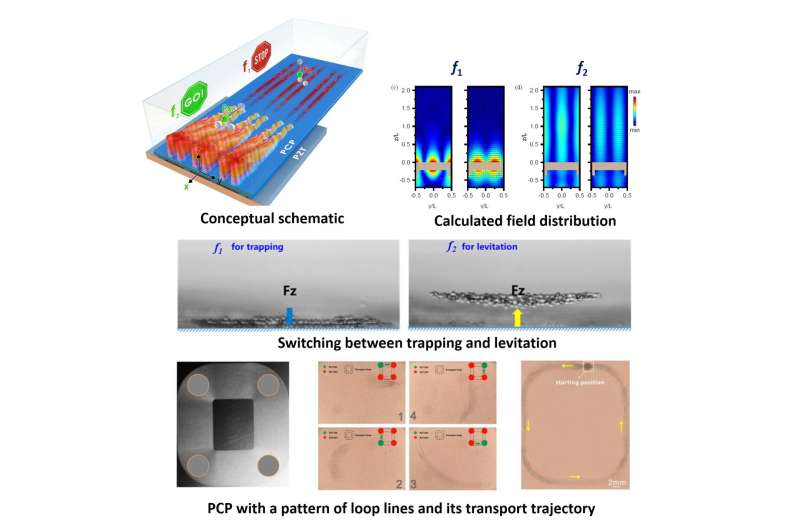Phononic crystal enabled dynamic manipulation of particles. Credit: SIAT
Acoustic tweezers are a powerful tool for contactless manipulation of particles and cells using acoustic radiation forces (ARF) generated by the transfer of acoustic wave momentum. They play an important role in display technology, biomedical sensors, imaging devices, diagnostic and others.
Although standing waves or sound beams have been used in acoustic tweezer devices to trap particles, a huge phased array or a displacement platform is needed to shift the wave phase or move the sound source for dynamic manipulation requiring time-variant acoustic fields. Currently, it's still a challenge to achieve dynamic manipulation in a tiny microchannel with a simple, flexible, low-cost and disposable method.
A research team led by Prof. Zheng Hairong from the Shenzhen Institutes of Advanced Technology (SIAT) of the Chinese Academy of Sciences has addressed the challenge of comprehensive, dynamic manipulation of particles and cells in a microchannel by integrating acoustofluidics, physics and fabrication of phononic crystals on the microscale.
In this study, a phononic crystal plate (PCP) fabricated by chemical etching and located in the microchannel created a tunable and time-variant sound field that generated a nonisotropic and reversible ARF that could be adjusted in real time.
The ARF originated from the interaction of the incident sound waves with the resonant excitation of two different modes in the phononic crystal plate.
The process switching from "stop mode" to "go mode" in side views. Credit: SIAT
These specific modes could be flexibly switched by simply changing the driving frequency. This change in frequency induced a highly localized acoustic field that generated a negative ARF to trap particles, along with a leaky field that caused a positive ARF to levitate particles, respectively.
In conjunction with an offset sound source setting for the PCP location, a radiation force induced by the field gradient along the channel could further transport levitated microparticles or cells toward the source along a certain predefined trajectory, such as a straight line, polyline line, arc line or loop line based on the straight line and arc line.
Massively parallel transport and switch between. Credit: SIAT
An arbitrary stop-and-go motion, namely, trapping and transportation, of particles and cells along a predefined path in the channel was achieved by switching the frequency so as to change the PCP' s resonant modes and by designing patterns on the phononic crystal plates in order to construct routes.
"By carefully designing and engineering acoustic fields using phononic crystals or metamaterials in microfluidic devices, a wide range of materials, particles, cells and organisms can be acoustically manipulated in a tunable and multifunctional manner for biomedical applications," said Prof. Zheng.
The study was published as an Editors' suggestion in the journal Physical Review Applied on April 30.
More information: Fei Li et al, Phononic-Crystal-Enabled Dynamic Manipulation of Microparticles and Cells in an Acoustofluidic Channel, Physical Review Applied (2020). DOI: 10.1103/PhysRevApplied.13.044077
Provided by Chinese Academy of Sciences
























